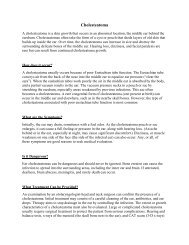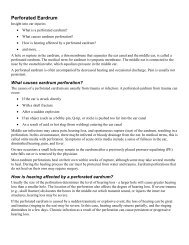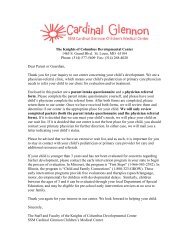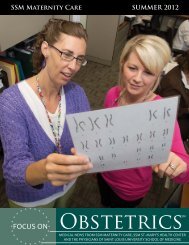Fall 2010 - SSM Cardinal Glennon Children's Medical Center
Fall 2010 - SSM Cardinal Glennon Children's Medical Center
Fall 2010 - SSM Cardinal Glennon Children's Medical Center
You also want an ePaper? Increase the reach of your titles
YUMPU automatically turns print PDFs into web optimized ePapers that Google loves.
Left: Using a video screen, Anand Palagiri, M.D., navigates through the ureter to the kidney to find Irhad Sehovid’s kidney stone. Using a laser fiber, he disintegrates the<br />
kidney stone and pulls out the smaller pieces. Right: Dr. Palagiri directs the laser fiber to the kidney stone and blasts it apart.<br />
It was a Monday morning at 5:00am when Irhad Sehovic, 15,<br />
woke up with a terrible pain in his left side.<br />
Silent Service<br />
Pediatric Stone <strong>Center</strong><br />
factors is initiated. What we do now will impact these children<br />
positively for the rest of their lives.”<br />
10<br />
“I tried eating something, but it wouldn’t go away,” he says.<br />
“It was the worst pain I have ever experienced.”<br />
When Irhad began vomiting, his parents rushed him to the<br />
emergency room. When his vomiting persisted even after<br />
medication, he was sent to <strong>Cardinal</strong> <strong>Glennon</strong> via ambulance.<br />
Emergency physicians diagnosed him with a kidney stone.<br />
Little did Irhad know he had been taken to the right place. In<br />
2007, <strong>Cardinal</strong> <strong>Glennon</strong> launched the Midwest’s first Pediatric<br />
Kidney Stone <strong>Center</strong> to address the painful problem that<br />
is increasing among young children.<br />
Kidney stones are caused by diet, dehydration or genetic<br />
factors, which must be addressed to keep stones from reoccurring.<br />
However, for children, once a stone has formed, they<br />
are usually difficult to pass due to the smaller caliber of the<br />
urinary tract. According to Dr. Palagiri, there is no stone the<br />
<strong>Center</strong> can’t remove in any child.<br />
“Kids have a bright future ahead of them when we deal with<br />
and treat the stones early on,” Dr. Palagiri says. “Currently, we<br />
offer state-of-the-art, minimally invasive techniques to remove<br />
stones. In collaboration with Dr. Ellen Wood and her team of<br />
nephrologists, a thorough evaluation of the etiology and risks<br />
To treat kidney stones, Dr. Palagiri established a protocol specifically<br />
tailored to children given the delicate nature of their<br />
urinary tract. It usually follows these steps and requires up to<br />
three separate procedures:<br />
1. Placement of a ureteral stent: The stent protects the<br />
kidney and ureter and alleviates the obstruction caused<br />
by the stone. At the same time, it dilates the ureter prior<br />
to the second procedure.<br />
2. Procedures:<br />
• Holmium Laser: Using a tiny camera and a scope,<br />
Dr. Palagiri inserts a small laser fiber that targets<br />
and breaks apart the stone so it can be removed in<br />
multiple pieces.<br />
• Extracorporeal Shock Wave Lithotripsy (ESWL):<br />
If the stone is in the kidney and can be seen on<br />
diagnostic x-ray, the <strong>Center</strong> may elect to use sound<br />
waves to target the stone. The stone is pulverized<br />
into sand and is much easier to pass. This option<br />
requires no invasion of the body.<br />
3. Stent Removal: When a stone requires manipulation to<br />
be removed, often times the ureter can swell shut after<br />
the intervention. In these cases, Dr. Palagiri will leave a<br />
stent behind to protect the ureter. He then removes it
















